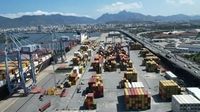Trade tensions between the United States and China have erupted once again, with Washington launching a formal investigation into Beijing’s compliance with the so-called Phase One trade deal. The probe, announced on October 24, 2025, by U.S. Trade Representative Jamieson Greer, is being carried out under Section 301 of the Trade Act of 1974—a tool the U.S. has used before to counter what it sees as unfair trading practices by other countries. The move comes at a particularly sensitive time: President Donald Trump, who famously spearheaded the original deal, was scheduled to head to Asia the same day, with a possible high-stakes meeting with Chinese President Xi Jinping looming in South Korea.
The investigation zeroes in on whether China has lived up to the commitments it made in the 2020 Phase One agreement, which Trump once called “an incredible breakthrough.” According to the Associated Press, the U.S. is especially focused on whether Beijing has truly ramped up its purchases of American goods—soybeans chief among them—and whether it has enacted promised reforms around intellectual property protection, technology transfer, and market access. A public hearing on the case is slated for December 16, 2025, setting the stage for what could be a dramatic escalation in economic hostilities between the world’s two largest economies.
China, for its part, wasted no time in firing back. On October 25, 2025, Beijing lodged a formal protest against the U.S. investigation, urging Washington to “immediately correct” what it called wrongful and unjust practices. Chinese Embassy spokesman Liu Pengyu, in a series of statements posted to X (formerly Twitter), insisted that China had “meticulously honored its agreement obligations through enhanced intellectual property protection, increased American imports, and expanded market accessibility.” He described China as “a major country that takes its responsibilities seriously,” and accused the U.S. of making “false allegations” and using the review process as a pressure tactic.
Liu didn’t stop there. He leveled counter-accusations at Washington, arguing that the U.S. has systematically escalated economic pressure against China even after the trade agreement was signed. He cited American export controls and investment restrictions as evidence of measures that “contradict the agreement’s spirit” and have inflicted “serious damage to bilateral and trade ties.” The rhetoric suggests that, despite diplomatic efforts to stabilize relations, the trust deficit between the two sides remains as wide as ever.
The backdrop to this renewed tension is complicated. The original Phase One deal, struck in early 2020 after years of heated negotiations and tit-for-tat tariffs, was supposed to be a truce. China agreed to dramatically step up purchases of U.S. exports—especially agricultural products like soybeans, which are vital to American farmers—and to implement structural reforms in areas including intellectual property and market access. But the COVID-19 pandemic hit just as the ink dried, disrupting trade flows and scuppering many of the deal’s ambitious targets.
By 2022, U.S. farm exports to China did hit a record, but the momentum didn’t last. Tensions have since escalated, with both sides imposing new trade restrictions. According to an analysis by the Peterson Institute for International Economics, China purchased only 58% of the total U.S. goods and services exports it had committed to under the agreement for 2020 and 2021. “It’s no secret that China did not live up to its obligations under the Phase One agreement, most notably its commitments to buy more U.S. goods,” Wendy Cutler, a former U.S. trade negotiator and now vice president at the Asia Society Policy Institute, told the Associated Press.
The current U.S. tariffs on Chinese products stand at a hefty 55%—a legacy of Trump’s first term. But the administration has threatened to pile on an additional 100% tariff, potentially bringing the total to a staggering 155%. Trump himself, while threatening these triple-digit tariffs in early October after Beijing expanded export rules on rare earth materials, admitted that such a move would be “not sustainable.” Still, the threat alone is a powerful bargaining chip as talks continue—or stall. According to Cutler, “the administration seems to be looking for new sources of leverage to use against Beijing, while adding another pressure point to get China to buy more U.S. soybeans as well as other goods.”
Beijing, meanwhile, maintains that it’s done its part. Liu Pengyu pointed to “enhanced intellectual property protection, increased American imports, and expanded market accessibility” as evidence that China has fulfilled its end of the bargain. Yet, from Washington’s perspective, the numbers just don’t add up. China, once the top overseas market for U.S. soybean farmers, has reportedly stopped buying American soybeans altogether amid the latest rounds of tariffs and counter-tariffs.
The investigation could have significant consequences. If U.S. officials determine that China failed to adequately implement its commitments—especially in sensitive areas like technology transfer and intellectual property protections—it could trigger a reinstatement of even harsher tariffs or other trade restrictions. The Office of the U.S. Trade Representative has made clear that the Section 301 investigation is designed to hold China accountable and to “counter unfair trading practices.”
For its part, China has warned that any further escalation could backfire, undermining not just bilateral ties but also global economic stability. In its formal protest, Beijing accused the U.S. of damaging the very relationship the Phase One agreement was meant to stabilize. The Chinese government has also highlighted its ongoing efforts to open its markets and protect intellectual property, arguing that the U.S. is selectively ignoring these reforms for political gain.
The timing of all this is more than a little awkward. President Trump’s trip to Asia, with a potential meeting with Xi Jinping in South Korea, has raised hopes among some observers that the two leaders might find a way to cool tempers and restart talks. But with both sides digging in their heels—and with the U.S. public hearing on the investigation looming in December—the prospects for a quick resolution seem slim.
As the world watches, the stakes couldn’t be higher. The U.S.-China trade relationship is not just about soybeans and tariffs; it’s about the rules of global commerce, the future of technology, and the ability of two superpowers to coexist without sliding into outright economic warfare. For now, the only certainty is that the coming weeks will be tense, with both sides maneuvering for advantage and the world economy hanging in the balance.
Whatever happens next, the outcome of this investigation—and the choices made by Washington and Beijing—will shape the global trade landscape for years to come.




